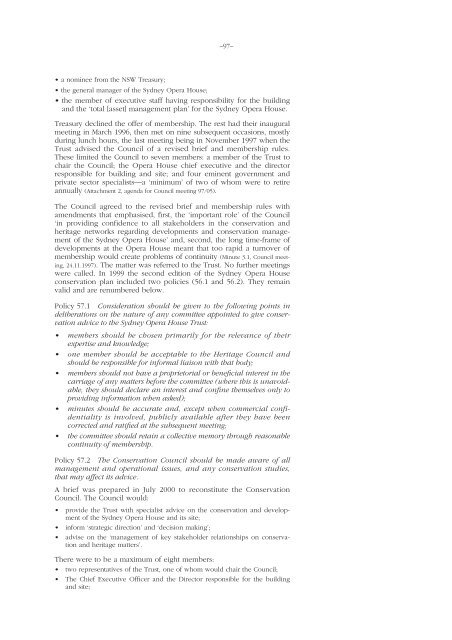Sydney Opera House conservation plan
Sydney Opera House conservation plan
Sydney Opera House conservation plan
You also want an ePaper? Increase the reach of your titles
YUMPU automatically turns print PDFs into web optimized ePapers that Google loves.
–97–• a nominee from the NSW Treasury;• the general manager of the <strong>Sydney</strong> <strong>Opera</strong> <strong>House</strong>;• the member of executive staff having responsibility for the buildingand the ‘total [asset] management <strong>plan</strong>’ for the <strong>Sydney</strong> <strong>Opera</strong> <strong>House</strong>.Treasury declined the offer of membership. The rest had their inauguralmeeting in March 1996, then met on nine subsequent occasions, mostlyduring lunch hours, the last meeting being in November 1997 when theTrust advised the Council of a revised brief and membership rules.These limited the Council to seven members: a member of the Trust tochair the Council; the <strong>Opera</strong> <strong>House</strong> chief executive and the directorresponsible for building and site; and four eminent government andprivate sector specialists—a ‘minimum’ of two of whom were to retireannually (Attachment 2, agenda for Council meeting 97/05).The Council agreed to the revised brief and membership rules withamendments that emphasised, first, the ‘important role’ of the Council‘in providing confidence to all stakeholders in the <strong>conservation</strong> andheritage networks regarding developments and <strong>conservation</strong> managementof the <strong>Sydney</strong> <strong>Opera</strong> <strong>House</strong>’ and, second, the long time-frame ofdevelopments at the <strong>Opera</strong> <strong>House</strong> meant that too rapid a turnover ofmembership would create problems of continuity (Minute 3.1, Council meeting,24.11.1997). The matter was referred to the Trust. No further meetingswere called. In 1999 the second edition of the <strong>Sydney</strong> <strong>Opera</strong> <strong>House</strong><strong>conservation</strong> <strong>plan</strong> included two policies (56.1 and 56.2). They remainvalid and are renumbered below.Policy 57.1 Consideration should be given to the following points indeliberations on the nature of any committee appointed to give <strong>conservation</strong>advice to the <strong>Sydney</strong> <strong>Opera</strong> <strong>House</strong> Trust:• members should be chosen primarily for the relevance of theirexpertise and knowledge;• one member should be acceptable to the Heritage Council andshould be responsible for informal liaison with that body;• members should not have a proprietorial or beneficial interest in thecarriage of any matters before the committee (where this is unavoidable,they should declare an interest and confine themselves only toproviding information when asked);• minutes should be accurate and, except when commercial confidentialityis involved, publicly available after they have beencorrected and ratified at the subsequent meeting;• the committee should retain a collective memory through reasonablecontinuity of membership.Policy 57.2 The Conservation Council should be made aware of allmanagement and operational issues, and any <strong>conservation</strong> studies,that may affect its advice.A brief was prepared in July 2000 to reconstitute the ConservationCouncil. The Council would:• provide the Trust with specialist advice on the <strong>conservation</strong> and developmentof the <strong>Sydney</strong> <strong>Opera</strong> <strong>House</strong> and its site;• inform ‘strategic direction’ and ‘decision making’;• advise on the ‘management of key stakeholder relationships on <strong>conservation</strong>and heritage matters’.There were to be a maximum of eight members:• two representatives of the Trust, one of whom would chair the Council;• The Chief Executive Officer and the Director responsible for the buildingand site;
















